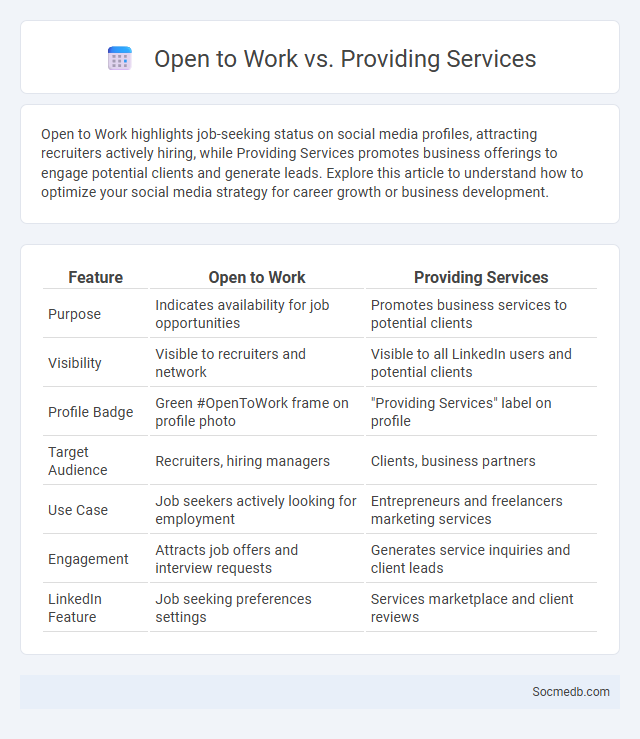
Photo illustration: Open to Work vs Providing Services
Open to Work highlights job-seeking status on social media profiles, attracting recruiters actively hiring, while Providing Services promotes business offerings to engage potential clients and generate leads. Explore this article to understand how to optimize your social media strategy for career growth or business development.
Table of Comparison
| Feature | Open to Work | Providing Services |
|---|---|---|
| Purpose | Indicates availability for job opportunities | Promotes business services to potential clients |
| Visibility | Visible to recruiters and network | Visible to all LinkedIn users and potential clients |
| Profile Badge | Green #OpenToWork frame on profile photo | "Providing Services" label on profile |
| Target Audience | Recruiters, hiring managers | Clients, business partners |
| Use Case | Job seekers actively looking for employment | Entrepreneurs and freelancers marketing services |
| Engagement | Attracts job offers and interview requests | Generates service inquiries and client leads |
| LinkedIn Feature | Job seeking preferences settings | Services marketplace and client reviews |
Understanding LinkedIn Profile Badges: An Overview
LinkedIn profile badges enhance your professional online presence by showcasing certifications, memberships, and achievements directly on your profile. These badges improve visibility in searches and build credibility with recruiters and industry peers. Understanding how to earn and display relevant LinkedIn badges can significantly boost your networking and career opportunities.
What Does the "Open to Work" Badge Mean?
The "Open to Work" badge on LinkedIn signals a user's active interest in new job opportunities, making their profile more visible to recruiters and hiring managers. This feature allows professionals to specify job titles, locations, and types of roles they are seeking, enhancing targeted networking possibilities. By displaying this badge, users increase their chances of being approached for relevant positions within their industry.
Exploring the "Providing Services" Badge
The "Providing Services" badge on social media recognizes profiles actively offering professional services, enhancing credibility and trust among potential clients. This badge highlights verified businesses or individual experts, making it easier for users to identify legitimate service providers and engage with them confidently. Earning this badge often involves meeting platform-specific criteria such as verifiable credentials, consistent service offerings, and positive user reviews.
The Purpose of the "Job Seeking" Badge on LinkedIn
The "Job Seeking" badge on LinkedIn serves as a powerful tool to signal your availability to potential employers and recruiters, enhancing your visibility in job searches. This badge leverages LinkedIn's algorithm to prioritize your profile in relevant job listings and networking opportunities, increasing your chances of landing interviews. By clearly indicating your job-seeking status, you optimize your profile for targeted engagement and professional connections tailored to your career goals.
Key Differences Between Open to Work, Providing Services, and Job Seeking Badges
Open to Work badges signal users actively seeking employment, making profiles more visible to recruiters on platforms like LinkedIn. Providing Services badges highlight freelance or contract offerings, attracting potential clients rather than employers. Job Seeking badges indicate a broader interest in new opportunities but may not specify full availability or freelance intent, catering to varied networking purposes.
When Should You Use Each LinkedIn Badge?
LinkedIn badges serve distinct purposes depending on your professional goals and network engagement; for example, the Profile Badge is ideal for personal branding on external websites, while the Company Badge promotes business pages and job postings. Using the Alumni Badge connects you with former classmates, enhancing networking opportunities within your educational community. Selecting the appropriate badge increases visibility, fosters targeted connections, and amplifies your digital presence effectively.
Visibility and Privacy Considerations for LinkedIn Badges
LinkedIn badges enhance professional visibility by allowing users to display their credentials directly on websites and email signatures, increasing network reach and credibility. Users must carefully manage privacy settings to control the information shared through these badges, balancing exposure with data protection. Ensuring that badges link only to curated profiles helps maintain a professional image while safeguarding sensitive personal details.
Impact of Badges on LinkedIn Networking and Opportunities
Badges on LinkedIn serve as powerful indicators of your skills, certifications, and achievements, enhancing your professional credibility and attracting recruiters' attention. These visual credentials increase profile visibility, making it easier for potential employers and collaborators to identify your expertise. By showcasing relevant badges, you can significantly expand your networking opportunities and improve your chances of landing new job offers or partnerships.
Best Practices for Optimizing Your LinkedIn Profile Badges
Optimizing your LinkedIn profile badges enhances your professional credibility by showcasing verified skills and certifications directly on your profile. Use high-resolution images for badges to maintain clarity and ensure they are relevant to your industry to attract the right professional connections. You can increase engagement by strategically placing badges in your summary section where they are highly visible to recruiters and colleagues.
Choosing the Right LinkedIn Badge for Your Career Goals
Selecting the appropriate LinkedIn badge enhances your professional profile by aligning with your specific career objectives and industry standards. Emphasizing badges that highlight skills, certifications, or industry recognition ensures visibility to recruiters and peers within your target field. Regularly updating badges based on evolving career goals maximizes LinkedIn's potential for networking and job opportunities.
 socmedb.com
socmedb.com